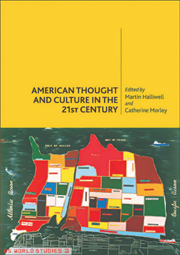Book contents
- Frontmatter
- Contents
- Acknowledgements
- Notes on the Contributors
- Introduction: The Next American Century?
- PART 1 POLITICS
- PART 2 SOCIETY
- PART 3 CULTURE
- 13 Contemporary American Culture
- 14 Cultural Pluralism and National Identity
- 15 Writing in the Wake of 9/11
- 16 American Ways of Seeing
- 17 Television and Digital Media
- 18 Animation and Digital Culture
- Bibliography
- Index
17 - Television and Digital Media
from PART 3 - CULTURE
Published online by Cambridge University Press: 05 August 2013
- Frontmatter
- Contents
- Acknowledgements
- Notes on the Contributors
- Introduction: The Next American Century?
- PART 1 POLITICS
- PART 2 SOCIETY
- PART 3 CULTURE
- 13 Contemporary American Culture
- 14 Cultural Pluralism and National Identity
- 15 Writing in the Wake of 9/11
- 16 American Ways of Seeing
- 17 Television and Digital Media
- 18 Animation and Digital Culture
- Bibliography
- Index
Summary
In February 1941, when publisher Henry Luce dubbed the 20th century ‘the American Century’, his magazine empire was about to fall prey to an even more dazzling media attraction: television. In May of that year, the Radio Corporation of America (RCA) procured government-sanctioned technological standards for its television receivers and eagerly planned for a consumer boom. Although commercial TV was delayed by World War II, in the 1950s television would become the signature technology of the American Century that Luce described, functioning both as a central fixture in the home and as a symbol (for better or worse) of the state of American democracy and culture. The growth of the new medium at mid-century was part of, and also helped precipitate, fundamental transformations in everyday life, and it also contributed to shifts in consumer habits, political campaigns and civic engagement, and society more broadly. While sociologists have for many years debated the nature and degree of these changes, almost everyone has some opinion on just what television has done to them, their nation and the world more generally.
Television penetrated American homes faster than any previous domestic technology. While in 1948 less than 2 per cent of US homes had a television set, by 1960 almost 90 per cent of US households had one or more TV. Yet, despite its popularity, television was prone to a wide range of anxious speculation, most of which belied more profound hopes and fears about technology, culture, and the social and political uncertainties of the post-war world.
- Type
- Chapter
- Information
- American Thought and Culture in the 21st Century , pp. 275 - 290Publisher: Edinburgh University PressPrint publication year: 2008



